Last updated: February 12, 2024
Article
The Plateau Postcard: Spring-Summer 2023
The Plateau Postcard is the official newsletter of the Southern Colorado Plateau Network (SCPN). We are one of 32 National Park Service Inventory and Monitoring Networks across the country established to collect, organize, analyze, and synthesize natural resource data and information about national parks, and provide the results in a variety of formats useful to natural resource managers. SCPN comprises 19 national park units located throughout the diverse landscapes of northern Arizona, northwestern New Mexico, southwestern Colorado, and southern Utah.
Most importantly, we are a community of individuals who collectively love the Colorado Plateau.
In this edition, we meet several new faces within SCPN, and head to the field with some of our spectacular monitoring crews. Every edition starts out with a postcard from us to you, dear reader, and this issue brings tidings from Glen Canyon National Recreation Area...

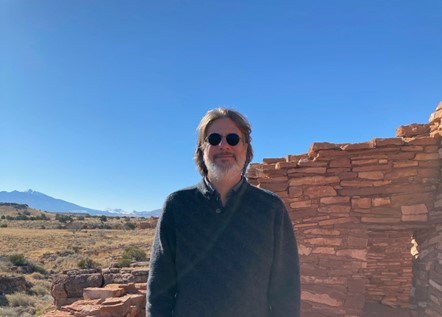
Christopher Calvo
Greetings Parks and Partners
Welcome to the first Plateau Postcard, a bi-annual newsletter from your local, and favorite, inventory and monitoring network. The Plateau Postcard was developed to share our activities and science, and we spotlight recent additions to the Network in this inceptive issue.
The past year has been an adventure for many. Sunset Crater and Walnut Canyon experienced the wettest monsoon on record, and Flagstaff is trying to spring from its second-highest snowfall year. Let’s hope recent precipitation marks the beginning of the end of drought’s reign in the region. Regardless of what the weather may hold, it was great to meet in person during the annual meeting this year. Thanks for making the journey!
Wishing you a safe, fun, and productive summer,
- Matthew

Translating the Plateau to a Logo
Everyone seems to have a cool logo these days, except us. Well, not anymore!
When the call was put out for logo ideas, yours truly, SCPN Science Communicator Christopher Calvo had a vision. As a person who grew up on the Plateau, currently lives and works on the Plateau, and most likely will die on the Plateau, I felt maybe I could capture a small essence of what the Plateau means to me and translate that into a logo that would make SCPN proud.
More art than graphic art, I looked to the landscape for my inspiration. From plentiful rock to scarce water, ancient messages, and sacred life (if you look hard enough). And of course, the two species that may represent the Plateau the best in my humble opinion: the common raven and the Utah juniper.
I also had the honor of collaborating with artist and SCPN hydrologic technician Raemy Winton to create a limited-edition woodblock print of the piece. The idea was to emulate historic Plateau explorer's technique of capturing landscapes, like the art of John Wesley Powell or Everett Ruess. Raemy painstakingly carved the image into a block of wood, paying special note to positive and negative spaces. After the pigment is spread over the block it is then pressed down firmly on special paper. Each print is wholly unique. Unique like any adventure you choose to take across this vast landscape we are lucky enough to live on.

Hannah Andrascik - Full Circle
Writer’s Note: Hannah’s journey is so interesting that it deserves a much more in-depth article than can be done in the confines of a newsletter. There is a broader story in the works, so please stay tuned…
Hannah Andrascik joined us here at the Southern Colorado Plateau Network in 2022 as the crew leader for upland vegetation and soil monitoring. Her story with the National Park Service however begins much earlier.
Her parents Karen and Roger Andrascik both worked for NPS when Hannah was born, and Hannah got the rare opportunity to actually grow up with a national park as her backyard. They lived together with Hannah’s brother Sean in park housing at Theodore Roosevelt National Park in North Dakota.
“Both our kids grew up around mainly adults when they were younger.” wrote Karen and Roger during our correspondence for this article. “They socially interacted with a wide range of park staff – park superintendents, division chiefs, naturalists, various “ologist,” administrators, maintenance workers, researchers, and volunteers.”
“(The park) was our place of solitude to recreate in whatever means it offered. It was particularly easy to take either early morning or late evening drives into the park to look for wildlife, or hike before or after most park visitors came or left. We were able to experience the seasonal changes that most people don’t see.”
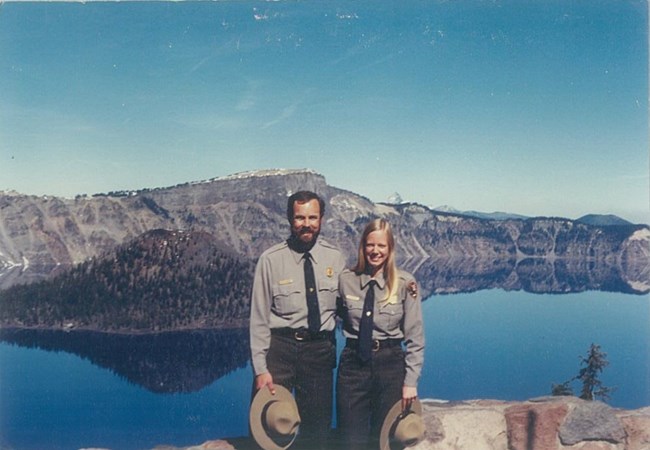
“My parents were very actively involved in our education, in and out of the classroom,” Hannah recalls. “While we were hiking, they’d often quiz us on the names of trees and ask questions about the places we would visit. My mom has always been great at reminding us to slow down and appreciate the little things. Sometimes when we would hike ahead, she’d ask us if we noticed the scat on the trail that we missed or heard the birds. My dad was great at showing respect to those you work with, even when you don’t always agree with them on everything. They both instilled a real pride in working for the park service.”
These experiences, as well as a great biology teacher named Mr. Clague, eventually culminated in Hannah starting a career with the National Park Service herself. And what a journey it has been so far.
Hannah has worked within eight national parks, monuments, and recreation areas, as well as two inventory and monitoring networks. One of the parks she worked in was none other than the park she spent a portion of her childhood, Theodore Roosevelt National Park.
“I hiked in places that I’d only ever experienced while being carried in a backpack.” says Hannah. “I was pretty young when we left Theodore Roosevelt so there were some folks who worked at the park who recognized me saying they remembered me as a baby! It was special getting to foster those relationships and have experiences that I would actually remember now that I was old enough.”
Hannah’s journey is an amazing full circle, and despite the fullness and richness of it already, it seems like it is only just beginning.
We here at SCPN can’t wait to see what happens next.

Christopher Calvo
Harrison Jones - Taking Flight
It must have been a strange sight to see for the pair of hikers that stumbled upon our group in the woods. Eight of us were standing silently in a circle, scribbling periodically in our individual notebooks. Listening intensely to our surroundings and blurring out all other distractions, including the hikers themselves when they said hello. After this seven-minute trance, Harrison (Harry) Jones says, “Times up, let’s compare what we have.” The point count spell was broken and we slowly came back to reality.I joined Harry, the Southwestern Avian Ecologist for SCPN, and the extremely knowledgeable upland bird crew on one of their intense training sessions. For three weeks Harry, Jane, Jon, Skip, Will, plus two guests from the North Coast Cascades Network, Mandy, and Melissa, travel the Colorado Plateau learning about birds, practicing point counts, and discussing the protocol. This ‘Bird Camp’ Harry has designed is so amazing and well thought out we could probably sell tickets to it.
For a couple of years, our important network bird studies were in limbo until Harry and the Institute of Bird Populations revived it. Harry simultaneously paid homage to the legacy data we have gathered over numerous years, as well as breathing new life into the project.
Instead of focusing on specific habitats like our previous monitoring efforts, Harry is trying to determine bird species richness and abundance park-wide. Monitoring is taking place currently at Bandelier National Monument (NM), Mesa Verde National Park (NP), Canyon de Chelly NM, Petrified Forest NP, Wupatki NM, and Grand Canyon NP.
Harry and the 2023 bird crew bring a deep passion for bird conservation with them. Their important work and analyses will bring us knowledge for years to come. If you see them in the field, however, don’t think we are rude if we don’t respond to a hello. Just wait seven minutes for the point count to end, and then we’d love to chat.

Christopher Calvo (photo taken at Wupatki National Monument)
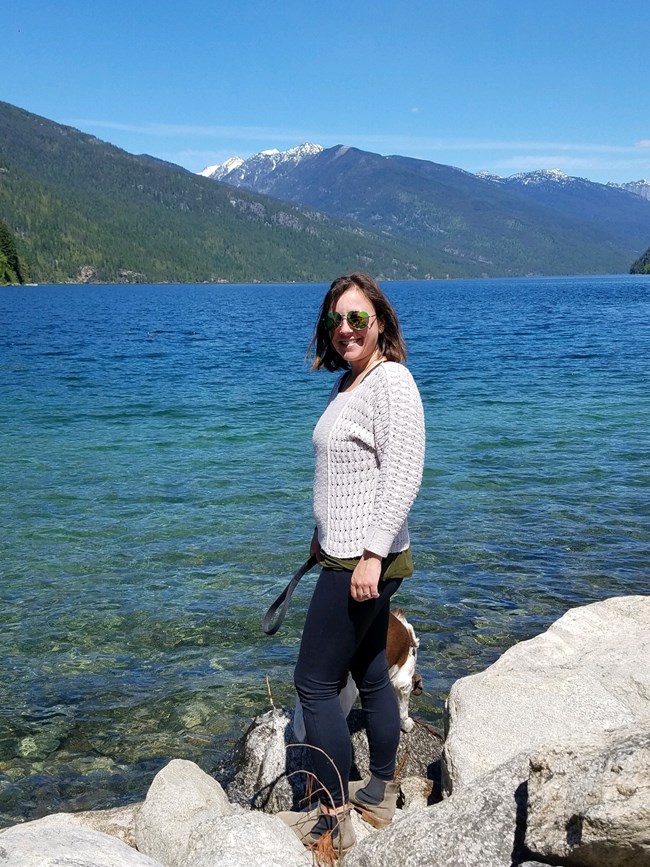
Laura Ploughe: The Currency of Long-term Monitoring is Data
The role that keeps us all together here at SCPN would undoubtedly have to be that of the Data Manager. Laura Ploughe and her family moved from British Columbia, Canada to the Colorado Plateau to join us at SCPN as the new, and much-needed Data Manager. The following interview took place in early Spring.
Where are you from and what put you on the path toward science?
I grew up in Quakertown, Pennsylvania, and went to the University of Pittsburgh for pre-med, but I quickly switched my degree to biology because I love the challenges that science presents.
I also enjoy teaching and decided to go back to school to get my Master’s in secondary education. After graduating I got a job as a science teacher at North Catholic High school in Pittsburgh, where I taught chemistry, physics, and environmental science for four years. During this time, I got married, and at the wedding, I had an interesting conversation with my Uncle Bob about getting my Ph.D.. With this bug in my ear, I started researching universities and their programs, and while I like many different sciences, I really began to like the idea of studying ecology. I applied for Ph.D. programs and decided to go to Purdue University where I got my Ph.D. in Biological Sciences as part of the Ecology and Evolution cluster.
What are some science projects you have worked on?
I have worked on studying the effects of climate change, specifically altered precipitation regimes, on ecosystem properties and plant communities. Also, I have worked on projects related to reclaiming degraded ecosystems like mines and rangelands. My main interests include working and collaborating with multidisciplinary teams to address and support the leading ecological questions regarding biodiversity and global environmental change to better inform conservation strategies.
Tell us about your family, and how has the transition been moving to northern Arizona.
My husband’s name is David, and he is a United States Marine Corps veteran who has thankfully followed me around as I follow my dreams. Our son’s name is Declan, and he is in second grade and loves the outdoors, Legos, and Minecraft. When we first moved to Flagstaff, we and our dog Milo, and cat Tommy, all camped out for a month together before we found our house. Since then, we got a kitten, Teddy, and a puppy, Willow, and it has been fun seeing my son play with the puppy and kitten in the backyard.
There are so many people we met along our journey so far and we miss them all.
What impresses me the most about our new home is how much beauty and change can be seen in the ecosystems over such short distances. It is so cool to see the landscape change as you drop in elevation. I am excited to continue to explore the wonderful landscape in this part of the country. And also excited to work towards improving our data management and our efforts in open science.

Christopher Calvo
Planting Some Knowledge
Stopping to think for a moment, Hannah Andrascik, the SCPN Upland Vegetation Field Crew Lead answers, “If an ant has to go around, it stops the gap.”
This interesting statement, and many other questions and answers were pondered upon in the shade of tall ponderosa pines along the north rim of Walnut Canyon National Monument. It is training week for the field crew and today's focus was basal gap. For those (like me!) who might not know what basal gap is, it is the space between plant bases that is not occupied by rooted vegetation when viewed as a vertical projection from the transect tape edge to the ground. This measurement could help show when an area might be experiencing erosion, among other things.
“And always remember the basal gap rules,” adds Megan Swan, the botanist and longtime principal investigator for upland vegetation and soils. “Live or dead. Nothing is too small. Annuals don’t count.”
As with any science group, the field scientists are the true shining stars. The heart and soul. The foundation of all our efforts. They get out there, rain or shine, and collect the data that can be applied to better understand ecosystem health. Like most field crews I have been a part of, everyone here comes across as long-lost friends, even though most of them just met each other less than a week ago.
Nick Bury has returned for his third field season with SCPN, and Camille McCollum for her second. Fern Bromley, Jessica Schatz, and Sam Wynsma are all here for the first time. Combined they bring together an immense amount of knowledge, passion, and energy.
“It’s always helpful to have returners from previous seasons to share the knowledge and experience with newer technicians.” Hannah says, “And the other folks are coming with lots of field experience from other regions of the US. I always appreciate people who can go with the flow, find joy in the little things and know how to make a fun group dinner! I’m sure that this crew will be no different, and I can’t wait to work together throughout the season.”
Here is to field science. May your data be sound, and may your basal cover be plentiful and perennial.

Hannah Andrascik (photo taken at Glen Canyon National Recreation Area)
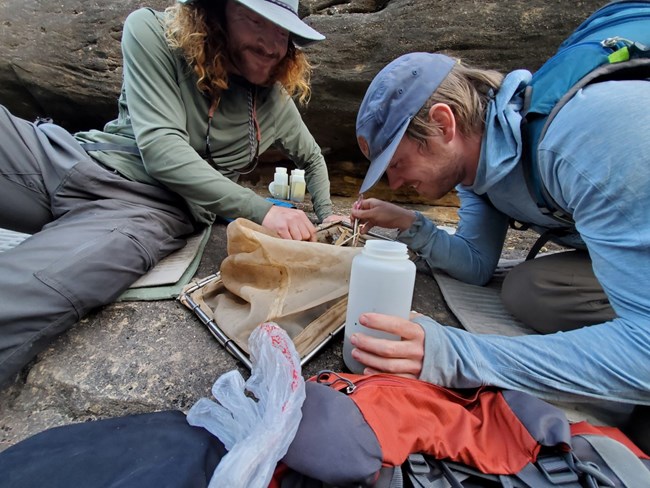
David Rakestraw (Photo taken in Grand Canyon National Park)
Water is Life - Tó éí iiná - El Agua es Vida
One of the hardest-working science crews on the Plateau would easily have to be the SCPN Water Resources Team. They work year-round, monitoring water quality, groundwater levels, and stream ecosystem health via aquatic macroinvertebrate communities. In fact, they work so hard that I was unable to get any interviews with anyone due to their busy field schedule.
David Rakestraw, the Hydrologic Technician/Water Resources Crew Lead did send along this great snapshot in the life of the crew, featuring the two new technicians, Stephen Gagnon (left) and Sam Wynsma (who you might also recognize from the Upland Vegetation Crew). They all backpacked in Grand Canyon to bring out water and insect samples from Garden Creek. Told you they were hard workers!
Recent Publication: Check out the latest report on IRMA by Stacy Stumpf, SCPN Stream Ecologist, titled: Stream Community Response to the 2011 Los Conchas Fire in Bandelier National Monument
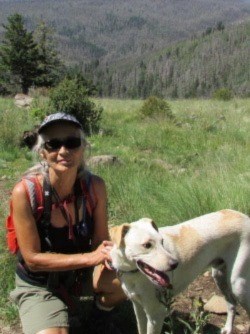
New Journeys
Jean Palumbo - Science Writer/Editor for SCPN 2009-2022.
Jean produced many incredible products for SCPN, including our website, story maps, videos, and science webinars. She also edited countless papers and taught us all to be better writers. Jean retired, still lives in Flagstaff, AZ, and has been on some amazing adventures of late including backpacking the 150 km long Wonderland Trail.
Previous to joining SCPN, Jean taught technical writing at Northern Arizona University (NAU), worked as a writer and editor for the Landscape Conservation Initiative at NAU, and was project coordinator for the Statewide Strategy for Restoring Arizona's Forests.
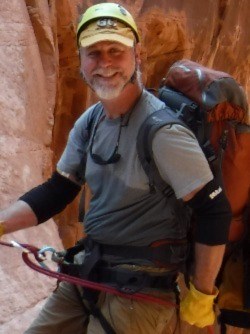
Lee worked hard to move our Data Management to the next level of compliance. He improved data validation by implementing R procedures and ported most of our databases into SQL Server designed for digital field data. Lee designed and created project databases, implemented digital data collections, developed reporting tools, and also helped so many of us learn R.
Before joining SCPN, Lee worked on conducting estuarine ecology research in Pacific Northwest estuaries for the US Department of Agriculture.
Lee and his family moved to the Boston, MA area where he joined the private sector (and they are lucky to have him).
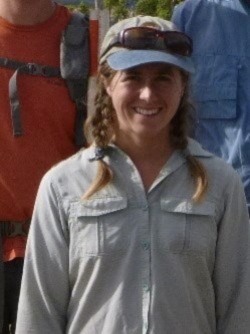
Carrie was a huge asset to our program. Starting as a crew member for the Upland Vegetation and Soil Monitoring crew, Carrie quickly worked her way up to the lead, where she ran crews all over the Plateau for many years. She now runs her own consulting company with her husband Steve (they met on our field crew) working on desert tortoise monitoring and also still doing botany projects in and around the Southwest.
Previous to Carrie joining SCPN, she worked with NPS as a Natural Resource and Watershed Stewardship intern, and as a Wilderness Ranger for the US Forest Service.
Thank you to all our former colleagues for all you have contributed to Plateau science.
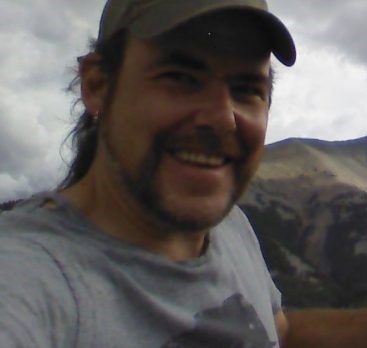
Science isn't done till it's been communicated...
Thanks, dear reader, for checking out the very first issue of the Plateau Postcard. The Fall/Winter issue will be full to the brim with science, I promise.
As far as all the new personnel here at SCPN goes...I guess that just leaves me, the new Science Communicator. My name is Christopher Calvo and I will give you a quick bio snapshot so I can leave some room to ask you an important favor. So here it goes...I have been a biologist on the Colorado Plateau for 19 incredible years, specializing in riparian bird ecology, like the Yellow-billed Cuckoo and the Common Blackhawk. I am lucky enough to be married to Ashley Doyle who is an herbalist, we have a pit bull named Mama Odie, and we live completely off-grid in the very center of a cinder cone that is part of the San Francisco Volcanic Field in northern Arizona. I also host a science show on the community radio station in Flagstaff, AZ.
Here is the favor to ask, if you are reading this and you need assistance in communicating science in any way, please don’t hesitate to reach out. We are all in this beautiful region together, doing our best, and I look forward to working with the parks in any way I can. Thanks for reading.

Southern Colorado Plateau Network - 930 N Switzer Canyon Dr. Suite 200, Flagstaff, AZ 86001
Tags
- aztec ruins national monument
- bandelier national monument
- canyon de chelly national monument
- chaco culture national historical park
- el malpais national monument
- el morro national monument
- glen canyon national recreation area
- grand canyon national park
- hubbell trading post national historic site
- mesa verde national park
- navajo national monument
- petrified forest national park
- petroglyph national monument
- rainbow bridge national monument
- salinas pueblo missions national monument
- sunset crater volcano national monument
- walnut canyon national monument
- wupatki national monument
- yucca house national monument
- inventory and monitoring division
- southern colorado plateau network
- upland vegetation
- bird biology
- water resources
- science communication
- aquatic invertebrates
- phenology
- newsletter
